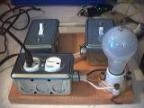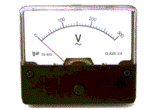On potential difference, electromotive force and voltage
Potential difference
 It is known that one body can be heated more and another less. The degree to which a body heats up is called its temperature. Similarly, one body can be electrified more than another. The degree of electrification of the body characterizes a quantity called electric potential or simply potential of the body.
It is known that one body can be heated more and another less. The degree to which a body heats up is called its temperature. Similarly, one body can be electrified more than another. The degree of electrification of the body characterizes a quantity called electric potential or simply potential of the body.
What does it mean to electrify the body? This means to inform it of an electric charge, that is, add a certain number of electrons to it if we charge the body negatively, or take them away from it if we charge the body positively. In both cases, the body will have a certain degree of electrification, that is, this or that potential, moreover, a positively charged body has a positive potential, and a negatively charged body has a negative potential.
A difference in the levels of electric charge between two bodies is usually called a difference in electric potential or simply a potential difference.
It should be borne in mind that if two identical bodies are charged with the same charges, but one is greater than the other, then there will also be a potential difference between them.
Furthermore, a potential difference exists between two such bodies, one charged and the other uncharged. So, for example, if a body isolated from the ground has a certain potential, then the potential difference between it and the ground (whose potential is considered zero) is numerically equal to the potential of this body.
So if two bodies are charged in such a way that their potentials are not the same, there is inevitably a potential difference between them.
Everyone knows the electrification phenomenon of the comb when you rub it on the hair is nothing but creating a potential difference between the comb and the human hair.
 In fact, when the comb is rubbed against the hair, some of the electrons are transferred to the comb, charging it negatively, while the hair, which has lost some of the electrons, is charged to the same degree as the comb, but positively. The potential difference thus created can be reduced to zero by touching the hair with a comb. This reverse electron transition is easily detected by the ear if an electrified comb is brought close to the ear. A characteristic popping sound will indicate continued discharge.
In fact, when the comb is rubbed against the hair, some of the electrons are transferred to the comb, charging it negatively, while the hair, which has lost some of the electrons, is charged to the same degree as the comb, but positively. The potential difference thus created can be reduced to zero by touching the hair with a comb. This reverse electron transition is easily detected by the ear if an electrified comb is brought close to the ear. A characteristic popping sound will indicate continued discharge.
Speaking above about the potential difference, we meant two charged bodies, the potential difference can also occur between different parts (points) of the same body.
So, for example, consider what happens in a piece of copper wireif, under the action of some external force, we manage to move the free electrons in the wire to one end.Obviously there will be a shortage of electrons at the other end of the wire and then a potential difference will occur between the ends of the wire.
As soon as we stop the action of the external force, the electrons will immediately, due to the attraction of different charges, rush to the end of the wire, positively charged, that is, to the place where they are missing, and the electrical balance will be restored in the wire.
Electromotive force and voltage
dTo maintain electric current in a wire, some external source of energy is needed to maintain the potential difference across the ends of that wire at all times.
These energy sources are so-called sources of electric tox, a definite electromotive force that creates and maintains a potential difference at the ends of the conductor for a long time.
Electromotive force (abbreviated EMF) is denoted by the letter E... EMF is measured in volts. In our country, the volt is abbreviated with the letter «B», and in the international designation - with the letter «V».
So to get a continuous flow electricity, you need an electromotive force, that is, you need a source of electric current.
The first such source of current was the so-called "voltaic pole", which consisted of a series of copper and zinc circles lined with skin immersed in acidified water. Thus, one of the ways to obtain electromotive force is the chemical interaction of certain substances, as a result of which chemical energy is converted into electrical energy. Sources of current, in which an electromotive force is created in this way, are called chemical sources of current.
Currently, chemical current sources — galvanic cells and batteries — are widely used in electrical engineering and energy.
Another main source of current, which has become widespread in all areas of electrical engineering and power engineering, are generators.

Generators are installed in power plants and serve as the only source of current to supply electricity to industrial enterprises, electric lighting of cities, electric railways, trams, subways, trolleybuses, etc.
As for chemical sources of electric current (cells and batteries), and for generators, the action of the electromotive force is exactly the same. It consists in the fact that the EMF creates a potential difference at the terminals of the current source and maintains it for a long time.
These terminals are called the poles of the current source. One pole of the current source always experiences a lack of electrons and therefore has a positive charge, the other pole experiences an excess of electrons and therefore has a negative charge.
Accordingly, one pole of the current source is called positive (+) and the other - negative (-).
Power sources are used to supply electrical current to various devices — current users… Current consumers using wires are connected to the poles of the current source, forming a closed electrical circuit. The potential difference that is established between the poles of the current source with a closed electric circuit is called voltage and is denoted by the letter U.
The unit for measuring voltage, like EMF, is the volt.
If, for example, you need to write down that the voltage of the current source is 12 volts, then they write: U — 12 V.
 For measuring EMF or voltage called a voltmeter device.
For measuring EMF or voltage called a voltmeter device.
To measure the EMF or voltage of a current source, a voltmeter must be connected directly to its terminals. Furthermore, if electrical circuit is open, then the voltmeter will show the EMF of the current source. If you close the circuit, the voltmeter will now show not the EMF, but the voltage at the terminals of the current source.
The EMF developed by the current source is always greater than the voltage across its terminals.
